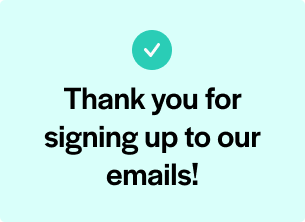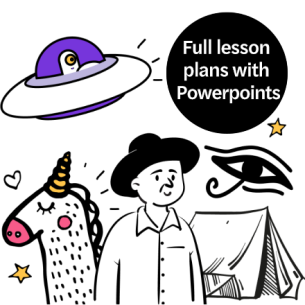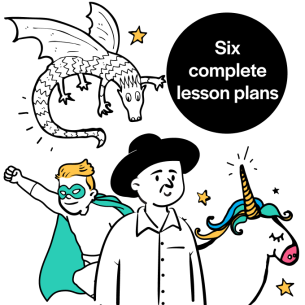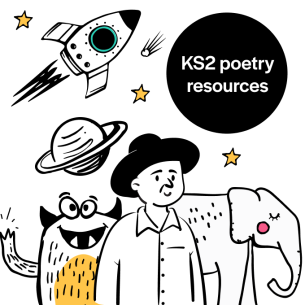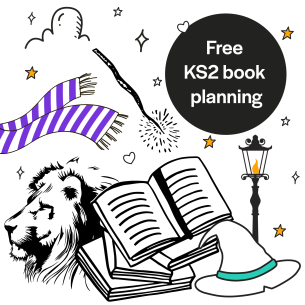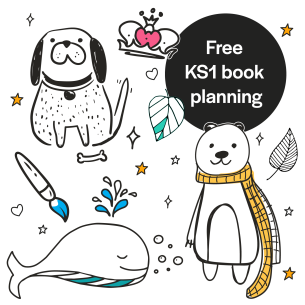The level of grammatical understanding needed rises significantly between LKS2 and UKS2. One area requiring a very strong grammatical understanding in KS2 is relative pronouns and relative clauses.
Introduced in Year 5, the national curriculum descriptor states that children should be: ‘Using relative clauses beginning with who, which, where, when, whose, that or with an implied (i.e. omitted) relative pronoun’.
So, what are relative pronouns and relative clauses, and how can KS2 pupils use them? Read the below teaching advice from KS2 teacher Sarah Farrell, then download our free accompanying resources.
Table of contents
What is a relative clause?
A relative clause is a type of subordinate clause that modifies a noun or a whole clause.
Modifying a noun
You can use a relative clause after a noun to add more information. In the following examples, we’ve put the noun in bold and have underlined the relative clause:
There’s the boy who stole my football.
In this example, the relative clause is referring to the boy.
The dog that I saw by the river looked like it was lost.
In this example, the relative clause is referring to the dog.
Modifying a clause
You can also use a relative clause after a clause to add more information. In the following examples, the clause being referred to is in bold and the relative clause is underlined. In both examples, the relative clause is adding information to the event that occurred in the main clause.
I lost my school jumper, which really annoyed my mum.
My friend was caught cheating in the test, which meant that he got a detention.
When KS2 children have a secure understanding of relative clauses, it enables them to be very precise in their writing and to express themselves clearly.
Most children already use relative clauses without realising it, but may find the punctuation of them difficult. This is where understanding the different types of relative clauses is beneficial.
Defining and non-defining relative clauses
The difference between defining and non-defining relative clauses essentially refers to whether we need to contain the relative clause within commas, brackets or dashes, or not.
KS2 pupils do not necessarily need to know the terminology of defining and non-defining relative clauses. However, using these terms may help children understand when they need to use commas, brackets and dashes.
Defining relative clause
The relative clause contains information that is essential for the sentence to make complete sense. You don’t contain the information within punctuation and you can’t remove it. For example:
Footballers who practise regularly are more likely to be picked for top teams than those who do not.
It is best not to approach dogs that you do not know.
Non-defining relative clause
The relative clause contains additional information that is not essential for the sentence to make sense. You contain this information within commas, brackets or dashes and you can remove it from the sentence without impacting the meaning. For example:
My sister, who is called Laura, is really annoying.
My dog, which is always hungry, munched the sofa.
In the sample 2016 SATs paper, there was a question which referred to this. Although children did not need to know the vocabulary of ‘defining’ and ‘non-defining’, they needed to be able to articulate how the introduction of commas changed the meaning of the sentence:
Explain how the use of commas changes the meaning of the two sentences.
Mangoes, which are grown in hot countries, taste delicious.
Mangos which are grown in hot countries taste delicious.
In their answer, children needed to refer to the fact that the first sentence suggests that all mangoes taste delicious and also grow in hot countries. This is unnecessary information added by the relative clause.
They would also need to explain that the second sentence suggests that only mangoes grown in hot countries taste delicious. In this example, the relative clause contains essential information, as the heat is relevant to the taste. Try the following example.
How do the commas change the meaning of the two sentences?
The children, who loved painting, enjoyed the art lesson.
The children who loved painting enjoyed the art lesson.
Relative clause resources
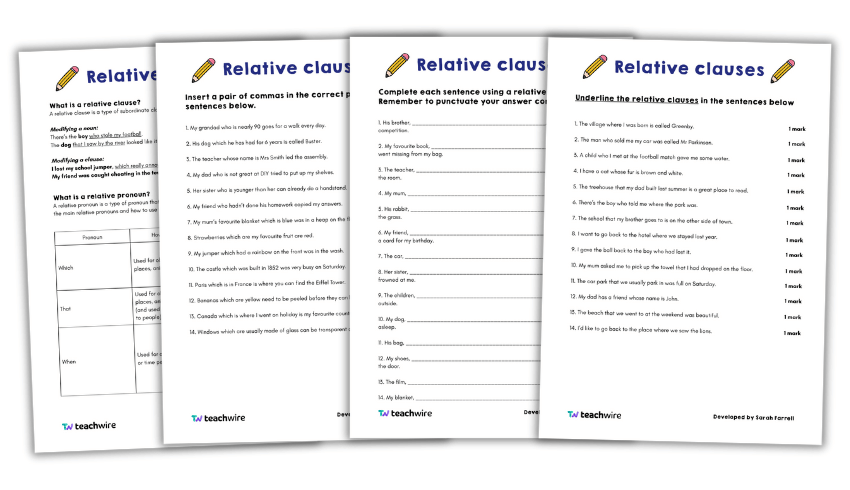
If you’re teaching relative clauses in KS2, these resources by Sarah Farrell are a brilliant, no-fuss solution. The info sheets clearly explain each relative pronoun (who, which, that, where, when, whose) with simple examples, making them perfect for displays, revision or guided practice.
The worksheets build skills step-by-step – first identifying clauses, then punctuating them correctly, and finally writing their own. They’re great for independent work, SPaG lessons or homework.
Download them from the top of this page.
What is a relative pronoun?
A relative pronoun is a type of pronoun that introduces a relative clause. Here are some of the main relative pronouns and how to use them:
| Relative pronoun | Use | Examples |
| Which | Objects, places, animals or events | Our dog, which is really naughty, tried to bite the postman. Our dog tried to bite the postman, which was really naughty of him. |
| That | Objects, places, animals and events (and, informally, to refer to people) | There’s the wall that my dad built last year. The hotel that we stayed at on holiday last year was really nice. |
| When | Time or a time period | On Tuesday, when it was the school play, I felt really nervous. In Victorian times, when the Industrial Revolution occurred, there was an increase in mechanical processing. |
| Where | Place | The park where the children play is really messy. The village where I grew up is really pretty. |
| Whose | Possession of a person or an object | I met a boy whose family come from Thailand. Mark has a dog whose ears are brown. |
| Who | Person or people | My friend, who is the same age as me, gave me a very special present. The child who lives next door to me is really annoying. |
| Whom | Person or people | I was introduced to a teacher whom I had never met before. We saw a child whom we had never liked. |
Who or whom?
The national curriculum does not mention the relative pronoun ‘whom’. However, it is one that children are often aware of, so it is useful to be able to explain if needed.
We use who when the subject is performing the action. In both of the below examples, the subjects are actively doing something. Often, we would use ‘who’ if the following word is a verb:
These are the people who are buying our house.
There’s the boy who won the award.
We use whom when the subject is receiving the action. In the following examples, the subjects are having the action performed on them.
In the first, they are being sold a house, and in the second the boy is being given the award. Often, we use ‘whom’ if the following word is a proper noun or a pronoun:
These are the people to whom we are selling our house.
There’s the boy with whom I am presenting the award.
Omitted pronouns
In some relative clauses, you can omit the pronoun without impacting the meaning. Here are some examples to demonstrate when relative pronouns can be omitted:
Defining relative clause
In a defining relative clause, you can often omit the relative pronoun when it is immediately followed by a pronoun or a proper noun. This is more common in speech than in writing.
Here is the house that we are moving to.
Here is the house we are moving to.
She showed me the dress which she had bought on Saturday.
She showed me the dress she had bought on Saturday.
Non-defining relative clause
You can’t omit the relative pronoun in non-defining relative clauses (those which we demarcate with brackets, dashes or commas). This is because the relative clause inside the punctuation would not be complete. For example:
My sister (who is younger than me) loves gymnastics.
My sister (is younger than me) loves gymnastics. (incorrect)
Relative pronouns clauses in SATs
There are several different ways that relative pronouns and relative clauses have appeared in KS2 GPS tests since 2016.
- Describing the grammatical term for the underlined words in a sentence, e.g.
The boys who were playing football were very polite. - Underlining the relative clause in a given sentence.
- Circling the relative pronoun in a sentence.
- Putting commas, brackets or dashes in the correct place in a sentence containing a non-defining relative clause, e.g. My sister who is younger than me is learning Polish.
- Writing a relative clause using given information, e.g.
Use the information in bold to complete the sentence below with a relative clause.
My grandma ________________ made me a cake.
My grandma loves baking. - Writing a relative clause without being given information.
- Inserting the correct relative pronoun into a sentence containing a relative clause.
- Selecting the sentence from a set of four that contains a relative clause.
- Ticking the correct relative pronoun to complete a relative clause.
- Ticking the part of the sentence that contains a relative clause.
Each test has featured between one and three relative clause or relative pronoun questions, often testing several different skills from the above list.
Teaching relative pronouns and relative clauses in KS2
First, it is important that children know when they should use different relative pronouns. After explicitly teaching each one through modelled examples, show incorrect examples for children to correct. Alternatively, provide the entire sentence without the relative pronoun and ask children to select the correct pronoun.
To introduce children to defining relative clauses (where commas, brackets and dashes are not required), give children the beginning part of a sentence and a relative pronoun and ask them to complete the sentence. Here are some examples that you can give for children to complete:
- There’s the dog that…
- Here’s the man who…
- This is the park where…
Pupils can then be creative in adding their own endings to the sentences. For example, you may end up with There’s the dog that stole my ball, or This is the park where I fell over.
To introduce KS2 children to non-defining relative clauses (where you need commas, brackets or dashes), it’s beneficial to look separately at adding relative clauses to modify nouns and clauses.
Modifying nouns
When teaching relative clauses to modify nouns, provide children with sentences containing nouns (or proper nouns or pronouns) and accompanying information to use. For example:
My dog, ___________________, dug holes in the garden.
Added information: My dog is really naughty.
You can then model taking the additional information and using it to form the following relative clause:
My dog, which is really naughty, dug holes in the garden.
Children can be creative with adding information to modify the noun in their own ways.
Modifying clauses
When teaching relative clauses to modify clauses, provide children with main clauses containing an easy-to-describe event. Ask them to think of either the consequence of that event or their opinion on it.
Maggie’s’ grandma gave her £10 for her birthday.
Opinion: Maggie’s grandma gave her £10 for her birthday, which was very generous of her.
Consequence: Maggie’s grandma gave her £10 for her birthday, which meant that she could afford to buy the book that she really wanted.
Supporting less confident writers to use relative clauses
Here are some suggestions for supporting children who may be struggling to understand relative clauses:
- Provide cloze sentences with a space for a relative clause (either with or without the relative pronoun. For example:
My cat, _____________, curled up with me.
My cat, which __________, curled up with me.
- Provide a range of main clauses and relative clauses for children to match up.
- For children struggling to understand how to add a relative clause, write a sentence on a strip of paper and cut it into two parts so the child can physically move them apart and insert the relative clause themselves.
- If you want children to use relative clauses to modify nouns, highlight or underline suggested nouns. For example: The cat fell asleep on me.
- Regularly look at different sentences together and discuss how the meaning has changed. For example:
The children, who loved reading, enjoyed the trip to the library.
The children who loved reading enjoyed the trip to the library.
Sarah Farrell is a KS2 teacher in Bristol who makes and shares resources online. Follow Sarah on X at @SarahFarrellKS2 and see more of her work at mrsfclassroom.wordpress.com
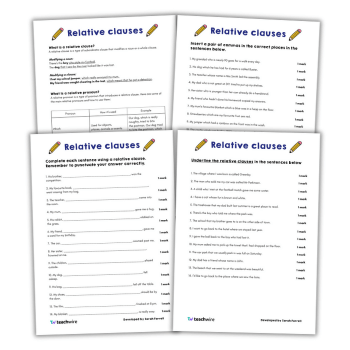
Similar resources
- No Refuge – Graphic novel activities about refugees for UKS2
- Short story writing – Author-led resources for KS1 and KS2
- Christmas activity sheets – KS1 / KS2 fun & educational printables
- Learning gaps – How to ensure no pupil drifts too far
- Writing horror – Write a scary scene with Fear Files: Hide & Seek


